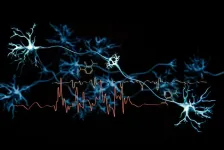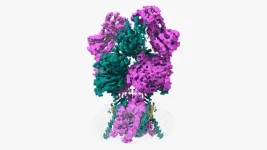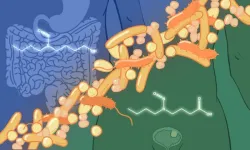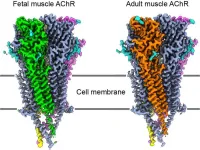(Press-News.org) A new study led by researchers at Durham University have uncovered an incredibly rare and detailed fossil, named Youti yuanshi, that gives a peek inside one of the earliest ancestors of modern insects, spiders, crabs and centipedes.
This fossil dates back over 520 million years to the Cambrian period, when the major animal groups we know today were first evolving.
This fossil belongs to a group called the euarthropods, which includes modern insects, spiders and crabs. What makes this fossil so special is that the tiny larva, no bigger than a poppy seed, has its internal organs preserved in exceptional quality.
Using advanced scanning techniques of synchrotron X-ray tomography at Diamond Light Source, the UK's national synchrotron science facility, researchers generated 3D images of miniature brain regions, digestive glands, a primitive circulatory system and even traces of the nerves supplying the larva’s simple legs and eyes.
This fossil allows researchers to look under the skin of one of the first arthropod ancestors. The level of complexity anatomy shows these early arthropod-relatives were much more advanced than the researchers thought.
Lead researcher, Dr Martin Smith of Durham University said: “When I used to daydream about the one fossil I’d most like to discover, I’d always be thinking of an arthropod larva, because developmental data are just so central to understanding their evolution.
“But larvae are so tiny and fragile, the chances of finding one fossilised are practically zero – or so I thought! I already knew that this simple worm-like fossil was something special, but when I saw the amazing structures preserved under its skin, my jaw just dropped – how could these intricate features have avoided decay and still be here to see half a billion years later?”
Study co-author, Dr Katherine Dobson of the University of Strathclyde said: “It’s always interesting to see what’s inside a sample using 3D imaging, but in this incredible tiny larva, natural fossilisation has achieved almost perfect preservation.”
Studying this ancient larva provides key clues about the evolutionary steps required for simple worm-like creatures to transform into the sophisticated arthropod body plan with specialised limbs, eyes and brains.
For example, the fossil reveals an ancestral ‘protocerebrum’ brain region that would later form the nub of the segmented and specialised arthropod head with its various appendages like antennae, mouthparts and eyes.
This complex head allowed arthropods to take on a wide range of lifestyles and allowed the researchers to become the dominant organisms in the Cambrian oceans.
Details like these also help trace how modern arthropods gained their incredible anatomical complexity and diversity and came to be the most abundant group of animals today.
The researchers point out that fossil fills an important gap in our understanding of how the arthropod body plan originated and became so successful during the Cambrian Explosion of life.
This remarkable specimen is housed at Yunnan University in China, where it was originally discovered.
ENDS
Media Information
Dr Martin Smith from Durham University is available for interview and can be contacted on martin.smith@durham.ac.uk.
Alternatively, please contact Durham University Communications Office for interview requests on communications.team@durham.ac.uk or +44 (0)191 334 8623.
Source
‘Digestive, vascular and nervous systems of a Cambrian euarthropod larva’, (2024), Martin Smith, Emma Long, Alavya Dhungana, Katherine Dobson, Jie Yang and Xiguang Zhang, Nature. https://doi.org/10.1038/s41586-024-07756-8
An embargoed copy of the paper is included in the below link and also available from Durham University Communications Office. Please email communications.team@durham.ac.uk.
Graphics
Associated images are available via the following link: https://www.dropbox.com/scl/fo/tx7pafs3o8r7iyhstznpc/ADgyHImABIifmb01iWEtmto?rlkey=riy7v4m3417c7mjdjnshw33h4&st=o37ddow5&dl=0
About Durham University
Durham University is a globally outstanding centre of teaching and research based in historic Durham City in the UK.
We are a collegiate university committed to inspiring our people to do outstanding things at Durham and in the world.
We conduct research that improves lives globally and we are ranked as a world top 100 university with an international reputation in research and education (QS World University Rankings 2025).
We are a member of the Russell Group of leading research-intensive UK universities and we are consistently ranked as a top 10 university in national league tables (Times and Sunday Times Good University Guide, Guardian University Guide and The Complete University Guide).
For more information about Durham University visit: www.durham.ac.uk/about/
END OF MEDIA RELEASE – issued by Durham University Communications Office.
END
520-million-year-old worm fossil solves mystery of how modern insects, spiders and crabs evolved
2024-07-31
ELSE PRESS RELEASES FROM THIS DATE:
A new use for propofol in treating epilepsy?
2024-07-31
The general anesthetic propofol may hold the keys to developing new treatment strategies for epilepsy and other neurological disorders, according to a study led by researchers at Weill Cornell Medicine and Sweden’s Linköping University.
In their study, published July 31 in Nature, the researchers determined the high-resolution structural details of how propofol inhibits the activity of HCN1, an ion channel protein found on many types of neurons. Drug developers consider inhibiting HCN1 a promising strategy for treating neurologic disorders including epilepsy and chronic pain. The researchers also found, to their surprise, that when HCN1 contains ...
Trust in physicians and hospitals during the COVID-19 pandemic in a 50-state survey of US adults
2024-07-31
About The Study: The results of this survey study of U.S. adults suggest that trust in physicians and hospitals decreased during the COVID-19 pandemic. As lower levels of trust were associated with lesser likelihood of pursuing vaccination, restoring trust may represent a public health imperative.
Corresponding Author: To contact the corresponding author, Roy H. Perlis, MD, MSc, email rperlis@mgh.harvard.edu.
To access the embargoed study: Visit our For The Media website at this link https://media.jamanetwork.com/
(doi:10.1001/jamanetworkopen.2024.24984)
Editor’s ...
State policies regulating firearms and changes in firearm mortality
2024-07-31
About The Study: In this comparative effectiveness study of state firearm policies, the joint effect estimates of combinations of firearm laws were calculated, showing that restrictive firearm policies were associated with substantial reductions in firearm mortality. Although policymakers would benefit from knowing the effects of individual policies, the estimated changes in firearm mortality following implementation of individual policies were often small and uncertain.
Corresponding Author: To contact the corresponding ...
City-level sugar-sweetened beverage taxes and youth body mass index percentile
2024-07-31
About The Study: Sugar-sweetened beverage excise taxes were associated with lower body mass index percentile among youth in this cohort study. Policymakers should consider implementing sugar-sweetened beverage excise taxes to prevent or reduce youth overweight and obesity and, ultimately, chronic disease, particularly among children younger than 12 years.
Corresponding Author: To contact the corresponding author, Deborah Rohm Young, PhD, email deborah.r.young@kp.org.
To access the embargoed study: Visit our For The Media website at this link https://media.jamanetwork.com/
(doi:10.1001/jamanetworkopen.2024.24822)
Editor’s ...
Impact of neighborhood resources on resilience after trauma
2024-07-31
E. Kate Webb, PhD, a research fellow at McLean Hospital who works in the Neurobiology of Fear Laboratory and Neurobiology of Affective and Traumatic Experiences Laboratory, led an investigation into whether individual resources and neighborhood resources, like greenspace, might impact neurobiology and the trajectory of posttraumatic stress disorder (PTSD) symptoms. Her research was published July 31st in JAMA Psychiatry.
What led you to examine the link between neighborhood characteristics and PTSD?
About 46 million people experience ...
Study finds nearly half of top cancer centers required universal masking during last winter’s COVID-19 surge
2024-07-31
Nearly half of the nation’s National Cancer Institute (NCI)-designated cancer centers required universal masking in key clinical areas during the winter 2023-2024 COVID-19 surge, according to a study by Tulane University researchers.
Overall, 41.8% of these 67 centers required some universal masking, according to the study, which published in JAMA Network Open. Further, 12 NCI-designated centers (18%) required universal masking in all areas. Masking policies were even more common in northeastern states and in centers with longer NCI designation, more funding and higher care rankings.
Those with cancer face higher risks from COVID-19 ...
This protein does “The Twist”
2024-07-31
Proteins are constantly performing a kind of dance. They move and contort their bodies to fulfill specific functions inside our bodies. The NMDAR protein executes an especially hard dance routine in our brains. One wrong step can lead to a range of neurological disorders. NMDAR binds to the neurotransmitter, glutamate, and another compound, glycine. These bindings control NMDAR’s dance steps. When their routine is over, the NMDAR opens. This open ion channel generates electrical signals critical for cognitive functions like memory.
The problem is that scientists couldn’t figure out the last step in NMDAR’s routine—until ...
Gut microbes implicated in bladder cancer
2024-07-31
At any given time, over 10 trillion microbes call our guts their home. From breaking down nutrients in our food to strengthening our immunity against pathogens, these microbes play an essential role in how we interact with the world. This includes – as shown in a new study by EMBL researchers and collaborators at the University of Split, Croatia – the way the body responds to carcinogens and develops cancer.
Carcinogens are chemicals that can cause ordinary cells to transform into cancer ...
Trust in physicians and hospitals declined over the course of the COVID-19 pandemic
2024-07-31
BOSTON– A cross-representative survey of adults in the United States showed decreasing levels of trust in physicians and hospitals during the COVID-19 pandemic—and the lower the trust, the less likely an individual was to get vaccinated against SARS-CoV-2 or influenza. The findings come from a survey study of more than 400,000 U.S. adults published in JAMA Network Open by a team co-led by investigators at Massachusetts General Hospital (MGH), a founding member of the Mass General Brigham healthcare system.
“Trust in ...
Unraveling a key junction underlying muscle contraction
2024-07-31
The connections between the nervous system and muscles develop differently across the kingdom of life. It takes newborn humans roughly a year to develop the proper muscular systems that support the ability to walk, while cows can walk mere minutes after birth and run not long after.
University of California San Diego researchers, using powerful new visualization technologies, now have a clear picture of why these two scenarios develop so differently. The results offer new insight into understanding muscle contraction in humans that may help in developing future treatments for muscular diseases.
“In this study we set out to understand ...




